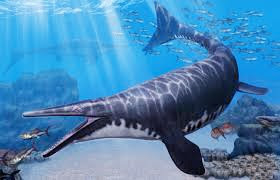In the depths of prehistoric seas, a colossal creature once roamed, dwarfing even the largest predators of its time. Recent findings have unveiled the existence of Ichthyotitan severnensis, a massive marine reptile that ruled the waters over 200 million years ago. Discovered by amateur fossil hunters, this astonishing creature sheds light on the wonders hidden within our planet's ancient past.
1. The Unveiling:
In 2016, on the shores of Somerset, UK, fossil hunter Paul de la Salle stumbled upon what would become a groundbreaking discovery. A fossilized jawbone, weathered by time and tide, hinted at the presence of an enormous creature from the past. Little did Paul know, he had unearthed the first known remains of Ichthyotitan severnensis.
2. A Family Affair:
Accompanied by his wife Carol, Paul's find sparked the interest of paleontologist Dr. Dean Lomax. Together, they embarked on a journey to uncover the secrets of this ancient giant. Their efforts culminated in a 2018 publication, which marked the beginning of a quest for more evidence.
3. A Second Jaw:
In 2020, the story took an exciting turn when father and daughter duo Justin and Ruby Reynolds made a remarkable discovery. Ten kilometers down the coast at Blue Anchor, they unearthed another massive jawbone, mirroring Paul's find. With this second specimen, the puzzle of Ichthyotitan severnensis began to take shape.
4. The Puzzle Pieces:
As fragments of the creature's jaw were pieced together, a clearer picture emerged. Dr. Dean Lomax, alongside Ruby Reynolds, co-authored a scientific paper detailing their findings. Based on the size of the jawbones—some over a meter long—it was estimated that Ichthyotitan severnensis reached lengths of about 25 meters, rivaling the size of a blue whale.
5. The Naming:
With their discoveries in hand, the team christened the colossal creature Ichthyotitan severnensis, honoring its origin near the River Severn. This new species of ichthyosaur represents a significant addition to the annals of paleontology, offering insights into the diversity of ancient marine life.
6. Amateur Contributions:
The story of Ichthyotitan severnensis is a testament to the invaluable contributions of amateur fossil collectors. From Paul de la Salle's initial discovery to the Reynolds family's subsequent find, these enthusiasts play a vital role in expanding our understanding of Earth's history.
Conclusion:
As Ichthyotitan severnensis prepares to make its public debut at the Bristol Museum and Art Gallery, we are reminded of the wonders that await discovery beneath our feet. This ancient sea reptile, brought to light by passionate individuals, invites us to marvel at the mysteries of our planet's distant past. In the tale of Ichthyotitan severnensis, we find not only a glimpse into prehistoric oceans but also a celebration of the curiosity and dedication that drive scientific exploration.
FAQs:
Q: What is Ichthyotitan severnensis?
A: Ichthyotitan severnensis is a newly identified species of giant ichthyosaur, an ancient marine reptile. It lived approximately 202 million years ago during the time of the dinosaurs.
Q: How was Ichthyotitan severnensis discovered?
A: The first remains of Ichthyotitan severnensis were found in 2016 by fossil hunter Paul de la Salle on a beach in Somerset, UK. In 2020, another jawbone was discovered by Justin and Ruby Reynolds, 10 kilometers away from the original site.
Q: How big was Ichthyotitan severnensis?
A: Based on the size of the jawbones found, scientists estimate that Ichthyotitan severnensis could have reached lengths of about 25 meters, making it longer than two nose-to-nose buses and comparable in size to a blue whale.
Q: What does the name "Ichthyotitan severnensis" mean?
A: "Ichthyotitan" means "giant fish lizard," reflecting its status as a massive marine reptile. "Severnensis" is derived from the River Severn in the UK, near where the fossils were discovered.
Q: Why is Ichthyotitan severnensis significant?
A: This discovery is significant because it sheds light on the diversity and size of ancient marine reptiles. Ichthyotitan severnensis represents one of the largest marine reptiles ever to swim in prehistoric seas.
Q: What other fossils have been found related to Ichthyotitan severnensis?
A: So far, the fossils found include jawbones, which have been crucial in estimating the size of the creature. More evidence, such as a complete skull and skeleton, is needed to confirm its exact size and characteristics.
Q: When will Ichthyotitan severnensis be displayed to the public?
A: The specimen found by Paul de la Salle will soon be on public display at the Bristol Museum and Art Gallery, offering visitors a chance to marvel at this ancient sea creature.
Q: Who were the key individuals involved in the discovery of Ichthyotitan severnensis?
A: Fossil hunter Paul de la Salle made the initial discovery in 2016. Paleontologist Dr. Dean Lomax played a significant role in studying and identifying the fossils. The Reynolds family, including Justin and Ruby Reynolds, contributed to the discovery by finding additional jawbone fragments.
Q: What is the significance of amateur fossil collectors in this discovery?
A: The discovery of Ichthyotitan severnensis highlights the importance of amateur fossil collectors. Paul de la Salle and the Reynolds family, among others, demonstrate how anyone with a passion for fossils can make groundbreaking discoveries, contributing to our understanding of Earth's history.
Q: Are there any plans for further research on Ichthyotitan severnensis?
A: Scientists hope to continue studying Ichthyotitan severnensis to learn more about its biology, behavior, and the environment it lived in. Further excavations and analyses may reveal additional details about this ancient sea reptile.
Q: Will Ichthyotitan severnensis receive a formal scientific description?
A: Yes, Ichthyotitan severnensis has already been described in a scientific paper co-authored by Dr. Dean Lomax and Ruby Reynolds. This paper provides details about the discovery, characteristics, and naming of the species.
Q: What can we learn from the discovery of Ichthyotitan severnensis?
A: The discovery of Ichthyotitan severnensis provides insights into the rich biodiversity of ancient marine ecosystems. It also highlights the collaborative efforts between amateur fossil hunters and professional scientists in advancing our knowledge of prehistoric life.




